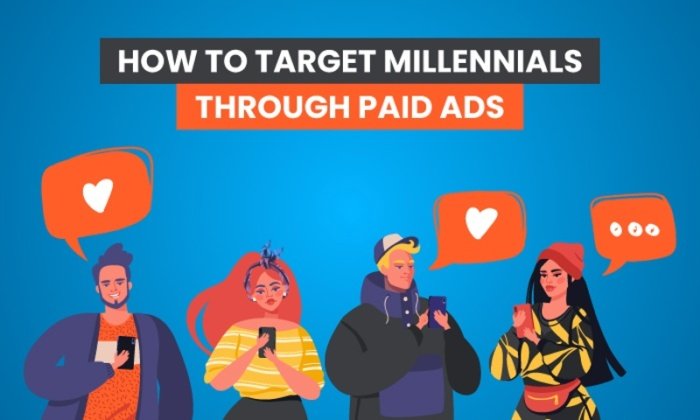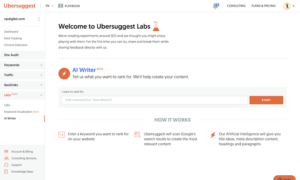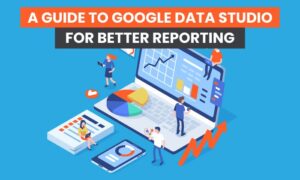Millennials are something of a mythical bunch in society. Much is said about their behaviors and preferences, yet many of the stories seem to contradict. Even narrowing down what age group millennials represent is challenging, and many people have differing views.
This confusing picture makes it challenging to target millennials through paid ads, but don’t let it put you off. Let’s look at who millennials are and how you can use that data to create targeted ads that will convince them to convert.
When Were Millennials Born?
Millennials are defined as “people reaching young adulthood in the early 21st century.” The Pew Research Center further defines the group as those born between 1981 and 1996, though that time period has shifted over time.
Millennials are now the most populous group in the US, making up 21.97 percent of the population, and this trend is set to continue well into the 2050s.
This makes understanding millennials crucial to creating paid ads that actually drive revenue.
What Makes Millennials Unique?
One of the key things that make millennials unique is their relationship with technology.
Millennials were born into a world where modern technology hadn’t yet taken hold in daily life like it has today. However, they did grow up in an age where technology was transforming the way we live, so they aren’t new to it.
Generation X adapted to digital technology as adults, and Generation Z have never known life without the smartphone or super-fast internet, but millennials have a foot in both worlds.
The rapid shift to a digital world means millennials’ lives have followed a different path to those generations before and after them. This has influenced them in many different ways.
Of course, it’s hard to ascribe common characteristics to such a diverse group, but some traits seem to be common in this generation, including:
- connected
- tech-savvy
- curious
- in need of instant gratification
- collaborative
- seek transparency
- crave authenticity
- care about diversity and sustainability
Keep in mind; this is just a rough picture of millennials. There are still individual people with unique politics, education levels, likes, and dislikes. However, these insights need to inform your paid ad strategy.
Why You Should Target Millennials Through Paid Ads
If you successfully target millennials through paid ads, you’ll engage 21.97 percent of the US population and 2 billion people worldwide. While millennials are more receptive to certain products, this is a huge market for virtually any business.
However, millennials pose several challenges to marketers. First, it is a large, diverse group, and secondly, they’re so accustomed to advertising that some think they’ve become immune to it.
Nobody is immune to advertising, and millennials click paid ads every day. The trick is finding the right strategy.
It starts with understanding your target audience. If your product doesn’t solve the problems millennials have or fit their view of the world, then this group shouldn’t be your primary target.
For example, businesses that provide traditional weddings and razor blade manufacturers have a notoriously difficult time advertising to millennials. This isn’t because this generation is immune to advertising, it’s because the products aren’t as closely aligned to the people’s wants and needs (think of the proliferation of beards in society today versus 20 years ago).
Instead, it’s businesses in travel, tech, fast food, and other sectors where the products match millennials’ specific pain points that are finding success.
If millennials are a key part of your target audience, then paid advertising is an effective option, because it allows you to reach these people where they’re “hanging out.” Ninety percent of millennials are on Facebook, making it exceptionally easy to reach these people with your message.
A key part of marketing is getting your message seen, and millennials give you ample chances to do this.
6 Strategies for Targeting Millennials Through Paid Ads
To successfully target millennials through paid ads, you have to remember this group is very tech-savvy, and they’ve grown up with online advertising.
They see through the cheap gimmicks and aren’t coerced into clicking for no reason. Therefore, you should focus on offering genuine value. The strategies you use to target millennials through paid ads must add to the experience, rather than just serving your own purposes.
Here’s a few ways to successfully target millennials with paid ads.
1. Run Ads on the Social Media Platforms Millennials Use the Most
The good thing about millennials is they are easy to reach. A huge percentage are active on social media, but to make the most of this, we need to understand what platforms millennials are using.
In the past, this was pretty easy. People had Facebook, Twitter, and maybe Instagram. There weren’t many other popular options. Today there are dozens of social media platforms, with new ones popping up every day.
Let’s look at what percentage of millennials use some of the most popular platforms weekly:
- Facebook: 87 percent
- Twitter: 42 percent
- Instagram: 71 percent
- Snapchat: 52 percent
- YouTube: 86 percent
- Pinterest: 42 percent
Additionally, LinkedIn’s audience is 38 percent millennials aside from these platforms, and 19 percent of millennials are using TikTok.
There are plenty of opportunities out there to target millennials through paid ads. The ability to reach this group isn’t difficult; the tricky part is getting your medium and message right.
These platforms rely on marketing revenues though, so they’re constantly innovating and finding new ways for advertisers to engage their users. For example, Pinterest Story Pins, or Instagram filters let you offer the experience millennials are looking for.
2. Create Paid Ads That Appeal to Millennial Values
Many studies point to millennials closely held values, and three that are commonly referenced are personal responsibility, diversity, and sustainability.
It’s no surprise, given that millennials make up such a large percentage of the population that these values are being highlighted more in advertising. We often see ads that reference issues that are close to millennials’ hearts, such as climate change and equality.
If your brand is active in these issues, then this is something you should be highlighting in your advertising.
Take Allbirds shoes. they entered the highly-saturated shoe market in 2015, where they faced huge competition. Through a highly-effective advertising campaign that played on their shoes’ sustainable credentials, sales have exploded, and today the company is worth $1.4 billion.
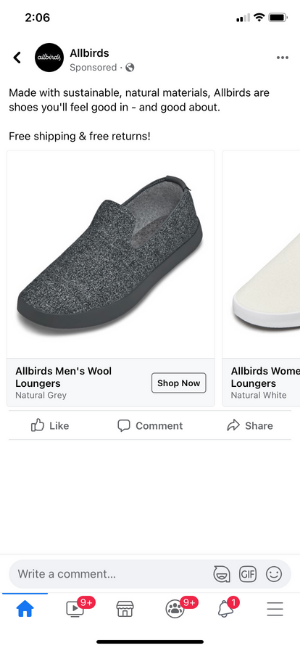
There’s no crazy marketing strategy, it’s just clear messaging that hits on people’s (millennial’s) values.
3. Be Upfront and Honest in Your Paid Ads Targeting Millennials
Millennials grew up in the digital age, and for the most part, they’ve seen all the tricks. They’re used to gimmicky advertising tricks to get their attention, and they learned to filter these out.
What cuts through the noise with millennials (and this is closely related to their values) is being honest and upfront with your advertising. This group knows if something sounds too good to be true, then it probably is, so there’s no point in over-promising and under-delivering.
This ties in with creating paid ads that appeal to millennials’ values; if you’re not serious about sustainability, or equality, or whatever it might be, then millennials are more likely to hold you to account.
This group grew up in a world of big (often faceless) corporations, but thanks to technology, they have a chance to see behind the branding and see the values behind a company. This can be a great opportunity for your advertising, but it’s got to be done in a clear, honest way.
For example, Allbirds doesn’t just use convenient slogans about sustainability in their paid ads. It’s a theme that’s central to its entire customer journey, and it delivers on its promises.
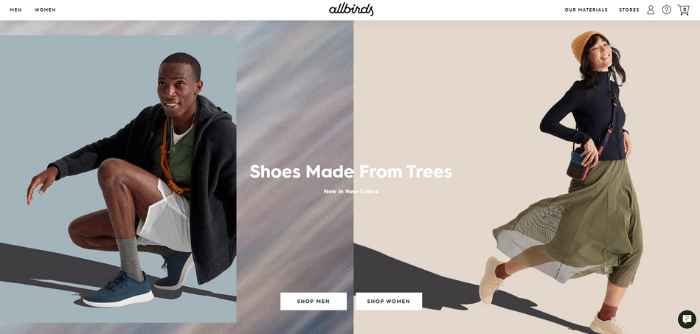
4. Create Funny Paid Ads to Target Millennials
Fifty-five percent of 13 to 35-year-olds send memes every week, and 30 percent do so daily. That’s a lot of memes!
Humor plays a huge role in millennial culture, and it’s something you can use in your paid ads. Funny ads are nothing new; just take a look back at some of the classic TV ads, but for some brands keep things very straightlaced online.
When used in content and ads, memes can have many benefits:
- They allow you to be creative.
- It’s an easy way to show your brand’s personality.
- They increase engagement.
- They’re easy to use.
- They are shareable.
People enjoy humor, and there’s certainly a place for it when you target millennials through paid ads. Just make sure your ads reflect the values of your business and resonate with your target audience. Otherwise, it can backfire.
5. Take Your Cue From Millennial Trends
The boozy brunch, avocado toast, and emojis are just some of the reported millennial trends in recent years. When 21.97 percent of the population enthusiastically gets behind something, you can bet it’s a factor to target with your marketing.
If you keep seeing something crop up in popular culture, then check it on Google Trends and see if it’s worth factoring into your marketing.

Remember that millennials are cynical consumers of advertising, so if it’s a reach to link your products to the trend, it’s probably best to leave it alone rather than look like you’re just trying too hard.
6. Ask the Millennials in Your Office for Help
One of the best ways to learn about your target audience is simply to ask them questions. Millennials now make up the largest proportion of the workforce, so there are bound to be some in your office.
Obviously, your co-workers have jobs to do, but it won’t hurt to run a few ideas by them. Millennials are a very diverse group, so they won’t be able to speak for everyone, but they might be able to give you some ideas about what works and what doesn’t with this generation.
Examples of Paid Ads Targeting Millennials
Brands are always trying to reach millennials through paid advertising, so there are lots of examples, some of which have had tremendous success, and others that are best forgotten. Let’s take a look at the best and the worst of the bunch.
The Good
Here are a few ads that nailed millennial marketing.
NFL and McDonald’s: Bad Lip Reading
This is a great example of brands capitalizing on millennial trends in a positive way.
In 2013, a series of YouTube videos found huge success by taking video footage of normal events and overlaying them with “bad lip reading.” One of the most successful videos was “The NFL: A Bad Lip Reading,” which has over 72 million views.
Rather than take offense at the light-hearted fun, the NFL embraced the trend and teamed up with McDonald’s to create their own version.
Airbnb: Belong Anywhere
Airbnb was founded in 2008 and was valued at over $100 billion when it went public in 2020. Part of its success has been a product that is closely aligned with the values of millennials, and its advertising continues to capitalize on this.
Messages such as “Let’s Keep Travelling Forward,” and “We Accept” fit perfectly with the ideals millennials respond to, and this has helped bring the company great success.
The Bad
What does it look like when millennial marketing goes wrong? Here are a few ads that missed the mark.
McDonald’s: Fish Fillet
It was widely accepted that McDonald’s missed the mark with its fish fillet ad because it’s seen as emotional manipulation.
Emotion is a big part of any ad, but it’s got to be done in the right way. This ad just seems like McDonald’s is using a child’s grief to sell its sandwiches, and that’s something millennials will see through.
Pepsi: Kendall Jenner Protest Ad
Millennials tend to feel a personal responsibility to make a positive change in the world, but brands that exploit that drive will suffer. For many people, this Pepsi ad featuring Kendall Jenner did just that.
Aired during a time of heightened tension around America, the ad seemed to trivialize the cause of the protests and struck the wrong chord with millennials.
Conclusion
Millennials are a diverse, tech-savvy group that were brought up with advertising, so it’s no surprise that it takes some fine-tuning to get your targeting right.
When you take the time to understand millennials, discover what values they hold dear, the platforms they engage with, and the types of content they respond to, then you will find you can successfully advertise to this group.
For some businesses, millennials simply won’t be part of their target market, but with this group making up over a fifth of the population, the majority of businesses are going to have to learn how to target them through paid ads.
Have you had success advertising to millennials?
The post How to Target Millennials Through Paid Ads appeared first on Neil Patel.

